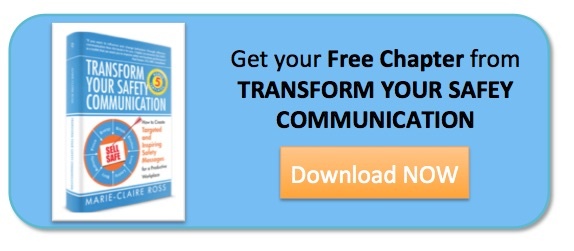As mentioned in " How to Develop a Workplace Safety Messages Campaign" Part 1, marketing is the key to getting your safety messages heard and understood.
Top 29 Catchy Safety Slogans
When it comes to getting staff to remember your important safety messages, using a safety slogan can be an effective way of getting the message through.
But not all safety slogans cut it. A lot of them are quite bland and well, just not catchy. Given that we're bombarded with around 3,000 messages a day, your safety slogan will become invisible and ineffective pretty quickly.
To ensure that your workplace safety communication is engaging, you need to have a stand out safety slogan. When choosing or designing your safety slogan, there are a few things you need to consider, to make sure your safety slogan is memorable.
1. Make it positive - Avoid creating a slogan that focuses on behaviour that you don't want. Instead, write a safety message that conveys what you want people to do. For example a negative slogan for height safety is "Don't fall for it". Using more positive language, a more appropriate version is "A harness is better than a hearse". While this might have negative connotations, it still focuses on what you want the person to do, rather than the wrong behaviour.
2. Keep it short (and tweet) - In this age of Twitter, being able to write in 140 characters or less helps you to distill your message. It's the same with writing a safety message, just try and encapsulate it in 8 words or less. Avoid long and complicated safety messages like "Don’t Fall Asleep At Work and Get Your Head Caught In a Splicing Bar" (too long, negative and not even funny) and "Mine Eyes Have Seen The Gory Of The Coming Of The Blood, It Is Pouring Down My Forearm In A Bright Red Crimson Flood" (is that really even a safety slogan? Seems more like an emo love poem).
3. Avoid jargon - Make sure the sentence flows easily. Avoid acronyms and words that not everyone will understand (see emo love poem above). To check that your slogan is easy to understand, ask yourself: "will my mum get this one?".
4. Contain a surprise - Common sense is the enemy of sticky safety messages. When our brain's guessing machine fails, it wants to work out why it was unable to guess. This surprise grabs our attention, so that we can be prepared in the future. By trying to work out what went wrong, our brain is more likely to remember the information.
Here's a good example (a personal fave): Hug your kids at home, but belt them in the car.
Slogans that contain the obvious will be ignored. Examples are: "Play it safe" and "Be aware, take care". Yawn!
5. Play on words - A clever play on words helps to make your safety message just that little bit more memorable. This can include rhyming and repeating words in a different order. Adding a little bit of fun can make a serious subject more approachable. Personally, the funnier the better, in my opinion.
For example:
Is better to lose one minute in life... than to lose life in a minute.
Know safety, no injury. No safety, know injury
Lifting's a breeze when you bend at the knees
Here are some more catchy slogans that meet memorable criteria:
While on a ladder, never step back to admire your work
Ten fingers, Ten toes, if you are not careful then, who knows?
Knock out... accidents
Shortcuts cut life short
Keep safety in mind. It will save your behind.
A spill, a slip, a hospital trip
Safety glasses: All in favor say "Eye!"
If you mess up, 'fess up
Behind the wheel, anger is one letter away from danger.
Chance takers are accident makers
Housekeeping you skip may cause a fall or slip.
It's easier to ask a dumb question than it is to fix a dumb mistake
Make it your mission, not to live in unsafe condition.
Safety comes in a can, I can, You can, We can be safe.
Safety fits like a glove; Try one on.
Safety is a full time job - don't make it a part time practice
Safety rules are your best tools.
Think smart before you start.
When safety is first, you last.
Electricity can turn you off.
You can't cure stupid (okay, this isn't a good safety slogan as it reinforces negative behaviour and doesn't reinforce what is required, but it made me laugh!)
Prepare & prevent instead of repair & repent.
To avoid a scene keep your work place clean.
Safety Shoes To House Your Toes; Safety Glasses on Your Nose.
Make sure you use a safety slogan that links well with your safety campaign. Once you've chosen your safety slogan, use it a lot. Put it in email newsletters, posters, stickers, training, safety conversations and use it in your safety meetings. Ideally, it's almost like a company "in joke" where people use it and giggle together.
And don't make the mistake that just because you have a safety slogan, that's enough. It's really important that you keep changing how you use it, so employees don't get fatigued by the message. A good resource to provide you with lots of ideas about your safety communication can be found in the book Transform Your Safety Communication. This highly acclaimed book provides 5 easy to use templates and frameworks to easily update your safety communication. Download a free sample chapter.
Have you got any favourite safety slogans?

